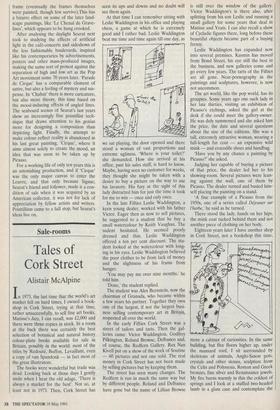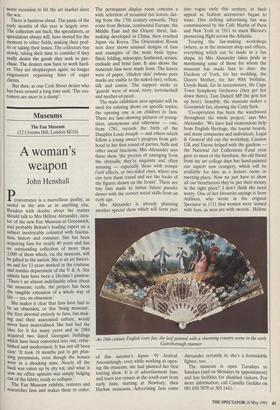Sale-rooms
Tales of Cork Street
Alistair McAlpine
In 1973, the last time that the world's art market fell on hard times, I owned a book- shop in Cork Street, trying at that time, rather unsuccessfully, to sell fine art books. Matisse's Jazz, I can recall, was £2,000 and there were three copies in stock. In a room at the back there was certainly the best selection of botanical and natural history colour-plate books available for sale in Britain, possibly in the world: most of the titles by Redoute, Buffon, Levaillant, even a copy of van Spandonk — in fact most of the great illustrators.
The books were wonderful but trade was dead. Looking back at those days I gently smile when I hear the old adage, 'There is always a market for the best'. Not so, at least not in 1973. Then, Cork Street has seen its ups and downs and no doubt will see them again.
At that time I can remember sitting with Leslie Waddington in his office and playing chess, a game at which he is extremely good and I rather bad. Leslie Waddington beat me time and time again till one day, as we sat playing, the door opened and there stood a woman of vast proportions and extreme ugliness. 'Where is your toilet?' she demanded. How she arrived at his office, past his sales staff, is hard to know. Maybe, having seen no customer for weeks, they thought she might be taken with a desire to buy a picture on the way to use his lavatory. His fury at the sight of this lady distracted him for just the time it took for me to win — once and only once.
In the late Fifties Leslie Waddington, a keen young dealer, worked with his father Victor. Eager then as now to sell pictures, he suggested to a student that he buy a small watercolour by Keith Vaughan. The sudent hesitated. He seemed poorly dressed and thin. Leslie Waddington offered a ten per cent discount. The stu- dent looked at the watercolour with long- ing in his eyes. Leslie Waddington believed the poor clothes to be from lack of money and the slightness of his frame from hunger.
`You may pay me over nine months,' he told him.
`Done,' the student replied.
The student was Alex Bernstein, now the chairman of Granada, who became within a few years his partner. Together they own one of the largest, if not the largest busi- ness selling contemporary art in Britain, respected all over the world.
In the early Fifties Cork Street was a street of tailors and tarts. Then the gal- leries came: Victor Waddington, Godfrey Pilkington, Roland Browse, Delbanco and, of course, the Redfern Gallery. Rex Nan Kivell put on a show of the work of Soutine — 60 pictures and not one sold. The real money in Cork Street has not been made by selling pictures but by keeping them.
The street has seen many changes. The Redfern is run in much the same way but by different people. Roland and Delbanco have gone but the name of Lillian Browse is still over the window of the gallery. Victor Waddington's is there also, after splitting from his son Leslie and running a small gallery for some years that deal in Matisse and Yeats. I can also recall a show of Cycladic figures there, long before these beautiful objects became part of a buying frenzy.
Leslie Waddington has expanded now into several premises. Kasmin has moved from Bond Street, his eye still the best in the business, and new galleries come and go every few years. The tarts of the Fifties are all gone. Near-pornography in the paintings and sculptures, however, is now not uncommon.
The art world, like the pop world, has its groupies. Some years ago one such lady in her late thirties, visiting an exhibition of Picasso's etchings, asked the girl at the desk if she could meet the gallery-owner. He was duly summoned and she asked him the price, the date and several questions about the size of the editions. She was a tall, extremely attractive woman, wearing a full-length fur coat — an expensive wild mink — and crocodile shoes and handbag.
`Have you by any chance a painting by Picasso?' she asked.
Judging her capable of buying a picture of that price, the dealer led her to his showing-room. Several pictures were lean- ing against the wall, one of them by Picasso. The dealer turned and busied him- self placing the painting on a stand.
`A fine example of a Picasso from the 1950s, one of a series called Dejeuner sur l'herbe,' he said as he turned.
There stood the lady, hands on her hips, the mink coat tucked behind them and not another piece of clothing on her body.
Eighteen years later I have another shop in Cork Street, not a bookshop this time, more a cabinet of curiosities. In the same building, but five floors higher up, under the mansard roof, I sit surrounded by skeletons of animals, Anglo-Saxon pots, crystals and other stones, sculpture from the Celts and Polynesia, Roman and Greek bronzes, fine silver and Renaissance jewels. My fire burns warmly in this the coldest of springs and I look at a stuffed two-headed lamb in a glass case and contemplate the worst recession to hit the art market since the war.
There is business about. The panic of the early months of this year is largely over. The collectors are back; the speculators, as speculators always will, have moved for the moment to other fields, making their prof- its or taking their losses. The collectors buy slowly, taking their time to consider if they really desire the goods they seek to pur- chase. The dealers now have to work hard- er. They are shopkeepers again, no longer ringmasters organising lines of eager clients.
But then, as one Cork Street dealer who has been around a long time said, 'The cus- tomers are nicer in a slump'.



























































 Previous page
Previous page